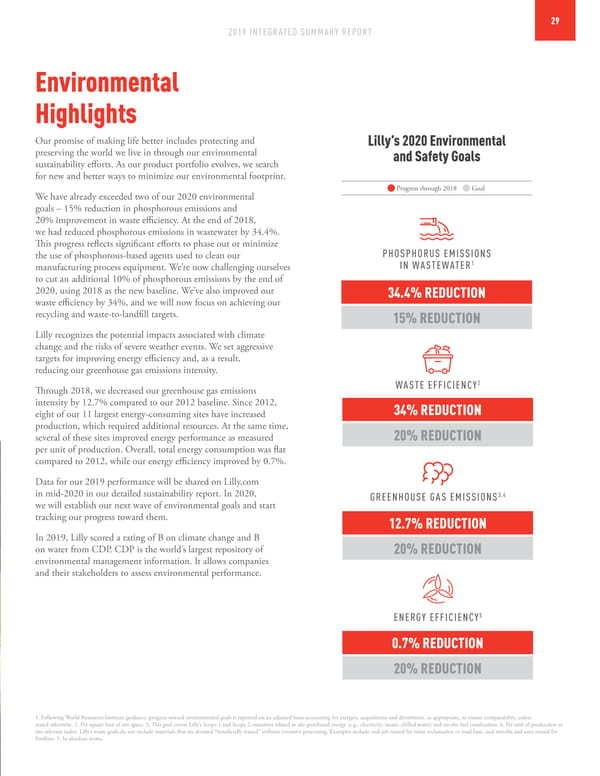29 2019 INTEGRATED SUMMARY REPORT Environmental Highlights Our promise of making life better includes protecting and Lilly’s 2020 Environmental preserving the world we live in through our environmental and Safety Goals sustainability efforts. As our product portfolio evolves, we search for new and better ways to minimize our environmental footprint. We have already exceeded two of our 2020 environmental Progress through 2018 Goal goals – 15% reduction in phosphorous emissions and 20% improvement in waste efficiency. At the end of 2018, we had reduced phosphorous emissions in wastewater by 34.4%. This progress reflects significant efforts to phase out or minimize PHOSPHORUS EMISSIONS the use of phosphorous-based agents used to clean our 1 manufacturing process equipment. We’re now challenging ourselves IN WASTEWATER to cut an additional 10% of phosphorous emissions by the end of 2020, using 2018 as the new baseline. We’ve also improved our 34.4% REDUCTION waste efficiency by 34%, and we will now focus on achieving our recycling and waste-to-landfill targets. 15% REDUCTION Lilly recognizes the potential impacts associated with climate change and the risks of severe weather events. We set aggressive targets for improving energy efficiency and, as a result, reducing our greenhouse gas emissions intensity. 2 Through 2018, we decreased our greenhouse gas emissions WASTE EFFICIENCY intensity by 12.7% compared to our 2012 baseline. Since 2012, 34% REDUCTION eight of our 11 largest energy-consuming sites have increased production, which required additional resources. At the same time, 20% REDUCTION several of these sites improved energy performance as measured per unit of production. Overall, total energy consumption was flat compared to 2012, while our energy efficiency improved by 0.7%. Data for our 2019 performance will be shared on Lilly.com in mid-2020 in our detailed sustainability report. In 2020, 3,4 we will establish our next wave of environmental goals and start GREENHOUSE GAS EMISSIONS tracking our progress toward them. 12.7% REDUCTION In 2019, Lilly scored a rating of B on climate change and B on water from CDP. CDP is the world’s largest repository of 20% REDUCTION environmental management information. It allows companies and their stakeholders to assess environmental performance. 5 ENERGY EFFICIENCY 0.7% REDUCTION 20% REDUCTION 1. Following World Resources Institute guidance, progress toward environmental goals is reported on an adjusted basis accounting for mergers, acquisitions and divestitures, as appropriate, to ensure comparability, unless stated otherwise. 2. Per square foot of site space. 3. This goal covers Lilly’s Scope 1 and Scope 2 emissions related to site-purchased energy (e.g., electricity, steam, chilled water) and on-site fuel combustion. 4. Per unit of production or site-relevant index. Lilly’s waste goals do not include materials that are deemed “beneficially reused” without extensive processing. Examples include coal ash reused for mine reclamation or road base, and mycelia and urea reused for fertilizer. 5. In absolute terms.
 Integrated Summary Report Page 29 Page 31
Integrated Summary Report Page 29 Page 31